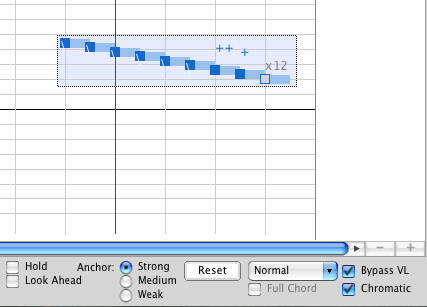
Posted
This thread is for all feedback and findings concerning the experimental feature "Chromatic Segment Flags".
A segment can be flagged to ignore voice leading constraints ("Bypass VL"). It may then use the entire vertical scale regardless of any limitations imposed by the interpretation and/or other instruments.
By setting the additional flag "Chromatic", all symbols except the anchor are allowed to use any chromatic note.
The anchor is still required to belong to the vertical scale, as a random anchor would not make sense. You still have the option of setting it to strong, medium or weak, which can drag it more towards a chord note, if desired.
The other symbols are interpreted as-is, namely the diatonic component is mapped against the scale (more precisely: the coordinate system of the respective symbol type), while the chromatic component is just added to it. It will not snap to the scale anymore, so every pitch is possible.
To ensure a melodic run in a particular direction (up/down), you should use a constant diatonic component and set the chromatic components of each symbol accordingly.
I haven't tested yet, but it should be possible to use fully diatonic symbols in the middle of a run, which is a nice option.
Hopefully I will get 1.1.3 finished until tomorrow, so we can start playing around with this.
Symbols with a chromatic component outside the standard range -2...2 are displayed with a slash in them. (segmentflags.png)

Thu, 2009-09-24 - 07:57 Permalink
Whan you say "fully diatonic symbols in the middle of a run,"
Do you mean like over a FMaj chord in Cmaj
B A G F E ?
This seems to be working very well and makes getting precise melodies an easier process.
Also what would you think would be more ideal, A default strategy with diatonic runs set to vl bypass, or setting the strategy to weak, so long as all the notes work out to be the same.
Thu, 2009-09-24 - 14:28 Permalink
Yes, fully diatonic means "well-defined, unaltered scale steps" here.
This however does not say anything about whether a certain note would be written with or without an accidental (#/b) in traditional notation.
Traditionally, the term "diatonic" refers to the major/minor tonal system, while in Synfire we use it for all sorts of scales. The diatonic component of a pitch symbol always refers to a scale step (except for static pitch symbols).
Regarding your other question: You shouldn't use non-VL segments as a default. You would loose the ability to play around with different VL strategies (Interpretation) and a disabled VL always means blurred and indifferent harmony (just "doodling" scales up and down).

